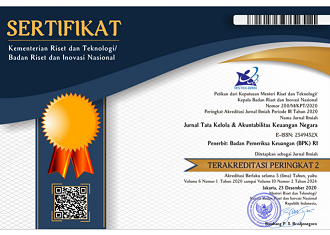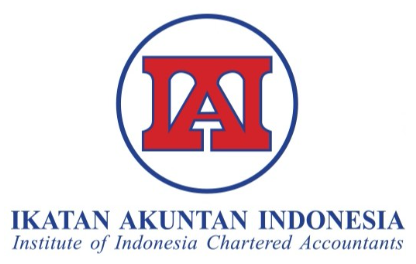Detecting the corruption pattern and measuring the corruption detection pace at the Indonesian village level
DOI:
https://doi.org/10.28986/jtaken.v9i2.1361Keywords:
audit, detection, development, village, corruptionAbstract
Despite widespread reports of corruption in 74,961 village authorities in Indonesia, the government has yet to establish an effective mechanism to detect and prevent corruption at the village government level. Therefore, this study provides an overview of corruption in villages by perpetrator profile, village development, and corruption detection pace to identify the highest-risk authorities exposed to corruption and implement preventive measures. Supported by a qualitative descriptive strategy for interpreting the data, this study analyzed 186 villages whose governing bodies engaged in corruption and were prosecuted by law enforcement officials from 2015 to 2021. The result shows that Java is more focused than other regions on prosecuting corruption cases in rural areas. Moreover, corruption cases in Java and Sumatra regions concentrate on developing villages. Outside of these two regions, most corruption occurs in disadvantaged villages. Village corruption cases were detected on average 2.72 years after the onset of corruption. These findings address a gap in previous research by exploring the variation in losses resulting from village corruption cases across different regions. The study underscores the significance of implementing regulations that mandate regular audits and other detection policies customized to specific attributes, such as region, development level, perpetrator profiles, and fraudulent scheme trends.
References
ACFE. (2022). Occupational fraud 2022: A report to the nations. Association of Certified Examiners (ACFE). https://acfepublic.s3.us-west-2.amazonaws.com/2022+Report+to+the+Nations.pdf
Antons, D., Grünwald, E., Cichy, P., & Salge, T. O. (2020). The application of text mining methods in innovation research: Current state, evolution patterns, and development priorities. R and D Management, 50(3), 329–351. https://doi.org/10.1111/radm.12408
BBC News Indonesia. (2022, February 24). Status tersangka Nurhayati resmi dibatalkan Kejaksaan - mengapa saksi pelapor korupsi 'belum cukup terlindungi'? BBC News Indonesia. https://www.bbc.com/indonesia/indonesia-60492886
BPK RI Official (2021, September). Workshop Anti Korupsi Seri II. (Video). https://www.youtube.com/watch?v=T86CiiQTN6A
BPKP. (2007). Fraud control plan. https://www.bpkp.go.id/public/upload/unit/investigasi/files/Gambar/PDF/fraud_control_plan.pdf
Brand, S., & Price, R. (2000). The economic and social costs of crime. Home Office Research Study
Chalfin, A. (2015). Economic costs of crime. In The encyclopedia of crime and punishment, 1–12. https://doi.org/10.1002/9781118519639.wbecpx193
Cohen, M. A. (2020). The cost of crime and justice. Routledge, Taylor & Francis Group. https://doi.org/10.4324/9780429431562
Cordery, C. J., & Hay, D. (2019). Supreme audit institutions and public value: Demonstrating relevance. Financial Accountability and Management, 35(2), 128–142. https://doi.org/10.1111/faam.12185
Dewi, H. R., Mahmudi, M., & Maulana, R. (2021). An analysis of fraud tendency of village government officials. Jurnal Akuntansi & Auditing Indonesia, 25(1), 33–44. https://doi.org/10.20885/jaai.vol25.iss1.art4
Dewi, S. S., & Arif, M. (2021). Analisis dampak dana desa terhadap pembangunan wilayah di Kabupaten Klaten (Undergraduate thesis, Universitas Muhammadiyah Surakarta). UMS Library. http://eprints.ums.ac.id/id/eprint/95305
Ferry, L., & Ahrens, T. (2021). The future of the regulatory space in local government audit: A comparative study of the four countries of the United Kingdom. Financial Accountability and Management, 38(3), 376-393. https://doi.org/10.1111/faam.12291
Fiorino, N., Galli, E., & Petrarca, I. (2012). Corruption and growth: Evidence from the Italian regions. European Journal of Government and Economics, 1(2), 126–144. https://doi.org/10.17979/ejge.2012.1.2.4281
Hakami, T. A., Rahmat, M. M., Yaacob, M. H., & Saleh, N. M. (2020). Fraud detection gap between auditor and fraud detection models: Evidence from Gulf Cooperation Council. Asian Journal of Accounting and Governance, 13(June), 1–13. https://doi.org/10.17576/ajag-2020-13-01
Heeks, M., Reed, S., Tafsiri, M., & Prince, S. (2018). The economic and social costs of crime. Home Office Research Studies. https://assets.publishing.service.gov.uk/media/5b684f22e5274a14f45342c9/the-economic-and-social-costs-of-crime-horr99.pdf
Indonesia Corruption Watch. (2017). Tren penindakan kasus korupsi 2016. https://icw.or.id/Zzd
Indonesia Corruption Watch. (2018a). Tren penindakan kasus korupsi 2017. https://icw.or.id/ZNS
Indonesia Corruption Watch. (2018b). Tren penindakan kasus korupsi 2018. https://antikorupsi.org/id/article/tren-penindakan-kasus-korupsi-2018
Indonesia Corruption Watch. (2020). Tren penindakan kasus korupsi 2019. https://icw.or.id/ZQA
Indonesia Corruption Watch. (2021). Tren penindakan kasus korupsi 2020. https://icw.or.id/nZU
Indonesia Corruption Watch. (2022). Tren penindakan kasus korupsi 2021. https://icw.or.id/ZJcj
Kementerian Desa Pembangunan Daerah Tertinggal dan Transmigrasi. (2017). Standar operional prosedur pemutakhiran status desa dengan indeks pembangunan desa. Kementerian Desa Pembangunan Daerah Tertinggal dan Transmigrasi
Leung, P., Coram, P., Cooper, B. J., & Richardson, P. (2015). Modern auditing and assurance services. In Massey University: Auditing Customised Text (6th ed.). Wiley.
Mamahit, A. I. (2018). Deteksi fraud pada sektor pemerintahan [Master’s thesis, Universitas Islam Indonesia]. UII Library Repository. https://dspace.uii.ac.id/handle/123456789/12670
Mecca, B., Mafira, T., Muluk, S., & Larasati, L. (2021). Indeks Desa Membangun Plus (IDM+): Meningkatkan insentif langsung untuk pemanfaatan lahan yang berkelanjutan. https://www.climatepolicyinitiative.org/wp-content/uploads/2020/11/Indeks-Desa-Membangun-Plus-IDM_Meningkatkan-Insentif-Langsung-untuk-Pemanfaat.pdf
Mechtenberg, L., Muehlheusser, G., & Roider, A. (2020). Whistleblower protection: Theory and experimental evidence. European Economic Review, 126(103447), 1–34. https://doi.org/10.1016/j.euroecorev.2020.103447
Mugellini, G., Bella, S. D., Colagrossi, M., Isenring, G. L., & Killias, M. (2021). Public sector reforms and their impact on the level of corruption: A systematic review. Campbell Systematic Reviews, 17(2). https://doi.org/10.1002/cl2.1173
Murphy, S. A. (2013). Data visualization and rapid analytics: Applying tableau desktop to support library decision-making. Journal of Web Librarianship, 7(4), 465–476. https://doi.org/10.1080/19322909.2013.825148
Nassaji, H. (2015). Qualitative and descriptive research: Data type versus data analysis. Language Teaching Research, 19(2), 129–132. https://doi.org/10.1177/1362168815572747
Nirmala, K., & Pushpa, M. (2012). Feature-based text classification using application term set. International Journal of Computer Applications, 52(10), 1–3. https://doi.org/10.5120/8235-1439
Olken, B. A. (2007). Monitoring corruption: Evidence from a field experiment in Indonesia. Journal of Political Economy, 115(2), 200–249. https://doi.org/10.1086/517935
Perry, J. (2021). Trust in public institutions: Trends and implications for economic security. United Nations, Department of Economic and Social Affairs Social Inclusion. https://www.un.org/development/desa/dspd/2021/07/trust-public-institutions/%0Awww.un.org/development/desa/publications/
Prabowo, H. Y., & Cooper, K. (2016). Re-understanding corruption in the Indonesian public sector through three behavioral lenses. Journal of Financial Crime, 23(4), 1028-1062. http://dx.doi.org/10.1108/JFC-08-2015-0039
Prabowo, H. Y., Cooper, K., Sriyana, J., & Syamsudin, M. (2017). De-normalizing corruption in the Indonesian public sector through behavioral re-engineering. Journal of Financial Crime, 24(4), 552–573. https://doi.org/10.1108/JFC-10-2015-0057
Pramudyastuti, O. L., Rani, U., Prativi, A., Fitri, G., Susilo, A., Tidar, U., Kapten, J., No, S., Magelang, K., & Tengah, J. (2021). Pengaruh penerapan whistleblowing system terhadap tindak kecurangan dengan independensi sebagai moderator. Jurnal Ilmiah Akuntansi, 6(1), 115–135. https://ejournal.undiksha.ac.id/index.php/JIA/article/download/32335/18497/0
Prasetya, Y. E., Dinanti, D., & Hidayat, A. R. R. T. (2020). Karakteristik pelayanan infrastruktur teknologi informasi dan komputer serta indeks desa berkembang di Kabupaten Probolinggo. Planning for Urban Region and Environment Journal (PURE), 9(1), 125–132. https://purejournal.ub.ac.id/index.php/pure/ article/view/39
Presidential Decree Number 54 of 2018 concerning the National Strategy of Corruption Prevention (Keputusan Presiden Nomor 54 Tahun 2018 tentang Strategi Nasional Pencegahan Korupsi). https://peraturan.bpk.go.id/Details/85918/perpres-no-54-tahun-2018
Prihatmanto, H. N., Artha, A. D., Joyonegoro, M. R., Munajat, M. D. E., & Irawati, I. (2022). Recognizing and detecting patterns of village corruption in Indonesia. Integritas: Jurnal Antikorupsi, 8(2), 205–220. https://doi.org/10.32697/integritas.v8i2.940
Prita, D. S. S., Wardayat, S. M., Liyati, E., & Firly M. S. A. (2020). Profiling selebriti fraud: Analisis profil koruptor di Indonesia. Jurnal Akuntansi Dan Pajak, 20(2), 266–275. http://dx.doi.org/10.29040/jap.v20i2.874
Rose-Ackerman, S., & Palifka, B. J. (2016). Corruption and government: Causes, consequences, and reform (2nd ed.). Cambridge University Press. https://doi.org/10.1017/CBO9781139962933
Saleh, L. O. I. H., & Ratmono, D. (2017). Analisis pengaruh korupsi terhadap audit pemerintah pada instansi pemerintah di Indonesia. Diponegoro Journal of Accounting, 6(1), 1–13. https://ejournal3.undip.ac.id/index.php/accounting/article/view/18285/17364
Sekretariat Nasional Pencegahan Korupsi. (2021). Laporan pelaksanaan strategi nasional pencegahan korupsi tahun 2020. https://www.stranaspk.id/publikasi/laporan-aksi/laporan-pelaksanaan-strategi-nasional-pencegahan-korupsi-triwulan-iii-tahun-2021
Seza, D. O., Sumardjo, M., & Ermawati, E. (2020). Analisis penerapan whistleblowing system dalam rangka penegakan integritas pada Badan Pemeriksa Keuangan. https://api.semanticscholar.org/CorpusID:225999630
Sinarto, B. P. (2018). Analysis of corruptors' demography to prevent corruption (study on court judgment at Bandung District) [Undergraduate thesis, Parahyangan Catholic University]. UNPAR Institutional Repository. https://lppm.stiekesatuan.ac.id/index.php/e-proceeding/article/download/590/440
Snyder, H. (2019). Literature review as a research methodology: An overview and guidelines. Journal of Business Research, 104(March), 333–339. https://doi.org/10.1016/j.jbusres.2019.07.039
Sukarno, M. (2020, Desember 1). Analisis pengembangan potensi desa berbasis indeks membangun desa (IDM) (studi kasus: Desa Ponggok, Kecamatan Palohharjo, Kabupaten Klaten) [Paper Presentation]. 1st International Conference Edusaintech, FMIPA Unimus, Semarang, Indonesia. https://prosiding.unimus.ac.id/index.php/edusaintek/article/viewFile/596/597
Šumah, Š. (2018). Corruption, causes, and consequences. In V. Bobek (Ed.), Trade and Global Market (pp. 63–80). IntechOpen. https://doi.org/10.5772/intechopen.72953
Suprajadi, L. (2009). Teori kecurangan, fraud awareness, dan metodologi untuk mendeteksi pelaporan keuangan yang curang. Bina Ekonomi: Jurnal Ilmiah FE Unpar, 13(2), 52–58. https://journal.unpar.ac.id/index.php/BinaEkono%20%20mi/article/view/722
Susilo, W. D., Angraeni, S., & Partohap, T. H. (2019). Survei penilaian integritas: Alternatif pengukuran kinerja pemberantasan korupsi. Jurnal Antikorupsi Integritas, 05(2), 165-189. https://jurnal.kpk.go.id/index.php/integritas/article/view/478
Sutarsa, I. N. (2014). Strategi penanggulangan korupsi di sistem pelayanan kesehatan yang integratif dan komprehensif. The Ary Suta Center Service on Strategic Management, 26, 161–191.
Suyatmiko, W. H. (2021). Interpreting the decline in Indonesia’s corruption perception index score in 2020. Integritas: Jurnal Antikorupsi, 7(1), 161–178. https://doi.org/10.32697/integritas.v7i1.717
Taqi, M., Ismail, T., Meutia, M., Sabaruddinsah, S., & Arifin, B. (2021). Village fund financial fraud prevention model using analytical hierarchy process method. Jurnal Organisasi Dan Manajemen, 17(2), 203–216. https://doi.org/10.33830/jom.v17i2.1366.2021
Taylor, J. (2018). White-collar crime and the law in nineteenth-century Britain. Business History, 60(3), 343–360. https://doi.org/10.1080/00076791.2017.1339691
Transparency International. (2020). Global corruption barometer Asia 2020: Indonesia. https://ti.or.id/global-corruption-barometer-2020-indonesia/
Transparency International. (2021). Corruption perceptions index. https://www.transparency.org/en/cpi/2021
Yang, F., Wu, H., & Yang, W. (2017). Research on the relationship between regional corruption and the performance of listed companies. Advances in Economics, Business, and Management Research (AEBMR), 37(2016), 1–20. https://doi.org/10.2991/ictim-17.2017.1
Yunan, Z. Y., Freyens, B., Vidyattama, Y., & Mohanty, I. (2023). Spread of corruption in Indonesia after decentralization: A spatiotemporal analysis. Oxford Development Studies, 51(2), 1–18. https://doi.org/10.1080/13600818.2022.2162493
Zakariya, R. (2020). Partisipasi masyarakat dalam pencegahan korupsi dana desa: Mengenali modus operandi. Jurnal Integritas, 6(2), 263–282. https://doi.org/10.32697/integritas.v6i2.670
Downloads
Submitted
Accepted
Published
How to Cite
Issue
Section
License
Copyright (c) 2023 Jurnal Tata Kelola dan Akuntabilitas Keuangan Negara

This work is licensed under a Creative Commons Attribution-ShareAlike 4.0 International License.

Jurnal Tata Kelola dan Akuntabilitas Keuangan Negara is licensed under
a Creative Commons Attribution-ShareAlike 4.0 International License




















